Standards on the Biodegradability of Surfactants in China
Yu Feng, Zhen Ren, Jianping Guo, Yuxia Li, Chenzhi Yao
China Research Institute of Daily Chemical Industry, China
Soaps and Detergents, indispensable for the maintenance of cleanliness, health and hygiene,played key roles in modern life. Almost everything,human body, human living environment as well as various industrial occasions, need to be clean enough to guarantee the sustainability of modern life. The consumption of soap and detergent is usually regarded as one of means to estimate the living standard and economy development of a country.
Surfactant production situation

With the fast development of Chinese economy,living condition in China has been improved dramatically.Market of soaps and detergents continued to expand in terms of both quantity and variety for about 30 years,though the growth rate has been slowed down recently due to economy recession. Consumption of surfactants also achieved a great growth, along with the increase of consumer market.
By 2014, according to the information Center of Surfactant and Detergent, the turnout of soaps and detergents in China reached 12,286,800 t; among which,7,600,000 t belonged to liquid detergent category and 4,680,000 t belonged to powder detergent (Table 1).[1]Meanwhile, production of surfactants stepped up,the total output of major surfactants in China in 2014 reached 2,390,000 t (Table 2); of which, anionic surfactants accounted for nearly 60%, while nonionic surfactants, as a result of rapid increase in recent years,amounted to over 25%. The rest were shared by cationic and emphoteric surfactants.

Table 1. Output of detergent products in China in 2014
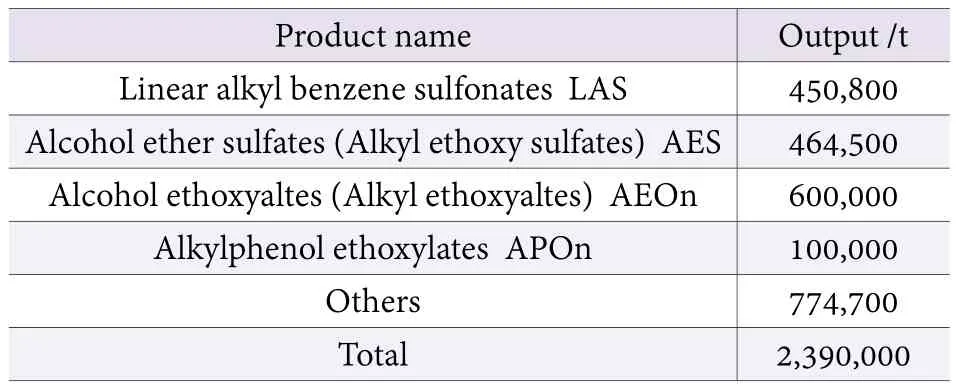
Table 2. Total output of major surfactants in China in 2014
However, environmental issue was aroused gradually along with extremely rapid expansion of surfactant production capacity. The first sign was seen in 2005,when European REACH (Registration, Evaluation,Authorisation and registration of Chemicals) became effective. Environmental property of surfactants drew much attention from both administrative authority and manufacturer. Some OECD[3]biodegradation test methods were adopted by China SAC (Standardization Administration of China) as Chinese national standard and Chinese REACH was taken into account by environmental authority, though more emphasize might be placed on the influence of European REACH on the exportation situation of surfactants to EU rather than the domestic environment impact as a result of consumption of surfactants at that time.
Sewage treatment in China
Currently, a large number of surfactant entered detergent industry, and were consumed comprehensively in form of detergent products. Hence, waste water treatment plant (WWTP), as the major recipient for detergent sewage, became crucial to surfactant industry.
in 2000,[2]there were only 427 of WWTP in China,and sewage water collection rate was about 34% merely.However, number of WWTP increased dramatically along with the economy development and fast urbanization in recent decade. in 2013, the number of WWTP reached 6,124, among which, 3,926 of WWTP located in urban area, 492 in various industrial zone and 1,706 in rural area across the country. The sewage water collection percentage achieved as high as 87% at the same time.
Thus, most of the surfactants used in detergent products were treated and biodegraded aerobically in aeration procedure in WWTP. Consequently, regulation on surfactant biodegradability, mainly in form of standard,concentrated on the aerobic biodegradation.
The rapid growth of WWTP facilitated the booming of detergent and surfactant industry, and the regulation, in the other hand, played a key role in this process, keeping balance between development and environmental protection.
Chinese standards regarding to chemical biodegradation test
There was few standards related to chemical biodegradation in China until 2008. The GB/T 15818-2006[4]was the only one in this field.
Since the REACH regulation has been taking effect ten years ago, many OECD methods concerning biodegradation of chemicals were adopted as Chinese standard by SAC. Ten test methods regarding to ultimatebiodegradation took effect in 2008, but the general outline did not come into force until 2012. Almost all the standards, except GB/T 27857-2011, are aerobic test.
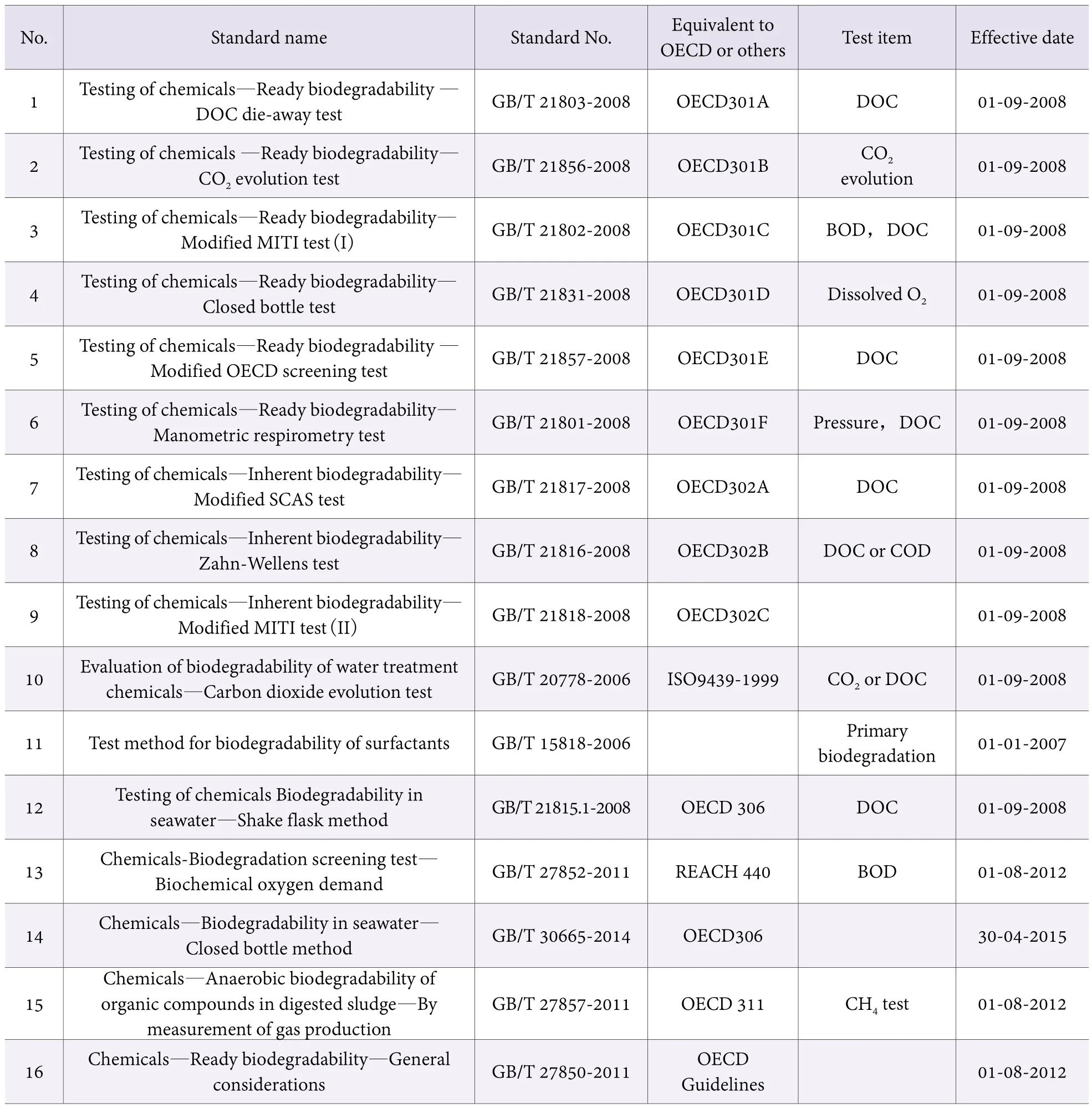
Table 3. Currently effective national standards for the determination of biodegradability of chemicals [5-19]
Table 3 listed the national standards currently effective and the original OECD counter part.
As we have seen in Table 3 that a majority of the Chinese standard, except GB/T 15818-2006, was adopted OECD method. The principal and test procedure are the same as that in OECD test method; while, the normative references have been converted into Chinese standard system necessarily.
Chinese standards regarding to surfactant biodegradation
The first level standard—Chinese REACH general guideline for chemical biodegradation.The standard in the first level regarding to chemical biodegradation is the Chinese REACH—Guide for the Registration of New Chemical Substance. As a sort of special chemical, new surfactant, if it is not in the list of China iECSC, needs the formal application for the registration to authority as a new chemical before commercial production/marketing/export.
For registration purpose, readily biodegradation test is needed. Totally 7 analytical institutions were officially authorized in 2009 by Ministry of Environmental Protection of the People’s Republic of China for new chemical registration test. Fortunately, most of the surfactants commercially available in the market had already been produced in China before the year of 2003. it suggested that they are not new chemicals. However, any newly developed surfactant with novel chemical structure is supposed to go through the registration procedure and conduct the necessary biodegradation test before formal application.
Technical specification for safety of soaps and detergents-GB/T 26396-2011.[20]Neither existed nor new chemical may be used in soap and detergent formulation if it does not meet the requirements of China national standard GB/T 26396-2011: Technical specification for safety of soaps and detergents. Compared with REACH, which is a general guideline for the safety of chemicals, national standard GB/T 26396-2011 is particularly specified for the safety of soaps and detergents in terms of definitions,product classifications, requirements, test methods and inspection rules. This standard is applicable to the cleaning products, including detergent for food or food equipment or food industry, personal care products and detergent for other purpose.
The pass criteria for the biodegradability of surfactant employed as raw material in soap and detergent formulation,for the first time, was clearly specified in the standard. The biodegradability, particularly the ultimate biodegradability,was taken into account and enrolled as an important item.
The pass criterion for biodegradability of surfactants was set as any of followings:
a) the primary biodegradability of surfactants shall not be less than 90%.
b) in cases where the primary biodegradability of surfactants is less than 90%, but more than 80%, the ultimate biodegradability shall not be less than 60%.
Particularly, alkyl phenyl ethoxylates and propylene tetramer alkybenzene sulfonate were strictly excluded from the raw material list as surfactant for the formulation of soaps and detergents .
GB/T 15818 (Test method for biodegradability of surfactants) was employed as test method for primary biodegradation, and GB/T 21801 (Manometric respirometry test), GB/T 21802 ( Modified MiTi test (i)) and GB/T 21831(Closed bottle test), GB/T 21856( CO2evolution test) were employed as ultimate biodegradation test method.
Test methods for the determination of surfactant biodegradability. As we have mentioned, GB/T 21801, GB/T 21802, GB/T 21831 and GB /T 21856 are based on OECD methods. However, national standard GB/T 15818-2006 is distinct from OECD method, specially in aspect of primary biodegradation test condition (Table 4).
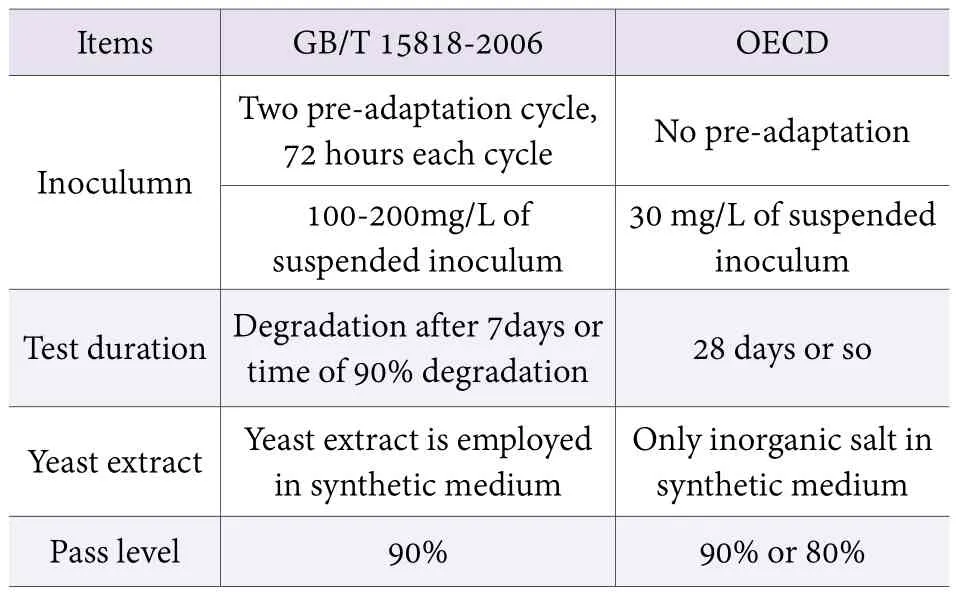
Table 4. Distinguishing features of GB/T 15818-2006 on primary biodegradation test condition
The key point of this standard is the pre-adaptation procedure which is excluded in many other methods. The activated sludge, pre-adapted to test surfactant sample solution by two cycles for 6 days totally (72 hours percycle),is inoculated and incubated in a synthetic medium containing 30 mg/L of test sample under shaking at controlled temperature. The degradability is calculated by the percentage of elimination (reduction of concentration)of the test sample after 7 days, and the pass level for primary biodegradability of test substance is over 90%.
GB/T 15818-2006, not only described the necessary condition of biodegradation test such as resource of inoculums, concentration of culture medium, environmental temperature, preparation of sample solution, in detail; but defined, specifying as 5 normative annexes, the analytical methods for the determination of concentration of various tested substance in biodegradation test liquor (Table 5).The tested substance usually belongs to various surfactant categories.
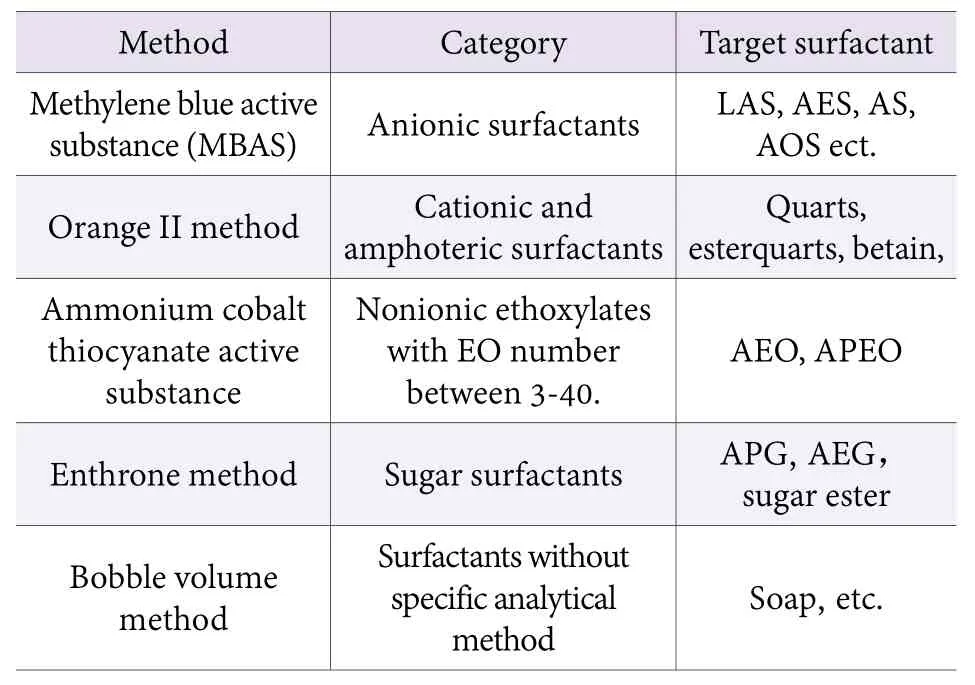
Table 5. Analytical methods employed in GB/T 15818-2006
Unlike the distinguished test condition, most of the analytical methods employed in GB/T 15818-2006 are similarly to that used in OECD (or detergent regulation of EU, No. 648).
Conclusion
At present, the architecture of biodegradation standard has been built up, and the guideline and procedure for primary/ultimate biodegradability test have been primarily established. These standards had irreversible impact on surfactant development and detergent market. More and more naturally originated surfactants are chosen as main ingredients in product formulations, of which green and environmental friendly are the claims. The number of biodegradation test performed by third-party inspector continues to grow recently, and growth of market share of green surfactant confirms this trend.
[1] Yongjie Zhao. Development Situation of China Surfactant industry in 2014. Detergent and Cosmetics 2015, 38 (5), 1-5.
[2] Qiang Wang; Yueying Wu; Yuli Wen; et al. Research on the Status and Problem of Waste Water Treatment Facilities Construction in China. Environmental Pollution & Control 2015, 37(3), 94-97.
[3] Organization for Economic Co-operation and Development.OECD Guidelines for Testing of Chemicals, Organization for Economic Co-operation and Development. Paris: OECD Publishing 1993, Section 3.
[4] General Administration of Quality Supervision. inspection and Quarantine of P.R.China. Standardization Administration of P.R.China. GB/T 15818-2006 Test Method for Biodegradability of Surfactants. Beijing, Standard Press of China 2007.
[5] General Administration of Quality Supervision. inspection and Quarantine of P.R.China. Standardization Administration of P.R.China. GB/T 20778-2006 Evaluation of Biodegradability of Water Treatment Chemicals—CO2Evolution Test. Beijing,Standard Press of China 2006.
[6] General Administration of Quality Supervision. inspection and Quarantine of P.R.China. Standardization Administration of P.R.China. GB/T 21803-2008 Chemicals—Ready Biodegradability—DOC Die-away. Beijing, Standard Press of China 2008.
[7] General Administration of Quality Supervision. inspection and Quarantine of P.R.China. Standardization Administration of P.R.China,.GB/T 21856-2008 Chemicals—Ready Biodegradability—CO2Evolution test. Beijing, Standard Press of China 2008.
[8] General Administration of Quality Supervision. inspection and Quarantine of P.R.China. Standardization Administration of P.R.China. GB/T 21802-2008 Chemicals—Ready Biodegradability—Modified MiTi Test [ Ⅰ] . Beijing, Standard Press of China 2008.
[9] General Administration of Quality Supervision. inspection and Quarantine of P.R.China. Standardization Administration of P.R.China. GB/T 21831-2008 Chemicals—Ready Biodegradability—Closed bottle Test. Beijing, Standard Press of China 2008.
[10] General Administration of Quality Supervision. inspection and Quarantine of P.R.China. Standardization Administration of P.R.China. GB/T 21857-2008 Chemicals—Ready Biodegradability—Modified OECD Screening Test. Beijing, Standard Press of China 2008.
[11] General Administration of Quality Supervision. inspection and Quarantine of P.R.China. Standardization Administration of P.R.China. GB/T 21801-2008 Chemicals—Ready Biodegradability—Manometric Respirometry Test. Beijing, Standard Press of China 2008.
[12] General Administration of Quality Supervision. inspection and Quarantine of P.R.China. Standardization Administration of P.R.China. GB/T 21817-2008 Chemicals—inherent Biodegradability—Modified SCAS Test [Ⅰ]. Beijing, Standard Press of China 2008.
[13] General Administration of Quality Supervision. inspection and Quarantine of P.R.China. Standardization Administration of P.R.China. GB/T 21816-2008 Chemicals—inherent biodegradability—Zahn-Wellens Test [Ⅰ] . Beijing, Standard Press of China,2008.
[14] General Administration of Quality Supervision. inspection and Quarantine of P.R.China. Standardization Administration of P.R.China. GB/T 21818-2008 Chemicals—inherent biodegradability—Modified SCAS Test [Ⅱ] .Beijing, Standard Press of China 2008.
[15] General Administration of Quality Supervision. inspection and Quarantine of P.R.China. Standardization Administration of P.R.China. GB/T 21815.1-2008 Chemicals—Biodegradability in seawater—Shake flask method [Ⅱ]. Beijing, Standard Press of China 2008.
[16] General Administration of Quality Supervision. inspection and Quarantine of P.R.China. Standardization Administration of P.R.China. GB/T 27852-2011 Chemicals-Biodegradation Screening Test—Biochemical Oxygen Demand. Beijing,Standard Press of China 2012.
[17] General Administration of Quality Supervision. inspection and quarantine of P.R.China. Standardization Administration of P.R.China. GB/T 27857-2011 Chemicals—Anaerobic Biodegradability of Organic Compounds in Digested Sludge-By Measurement of Gas Production. Beijing.Standard Press of China 2012.
[18] General Administration of Quality Supervision. inspection and Quarantine of P.R.China. Standardization Administration of P.R.China. GB/T 27850-2011 Chemicals—Ready Biodegradability—General Considerations. Beijing, Standard Press of China 2012.
[19] General Administration of Quality Supervision. inspection and Quarantine of P.R.China. Standardization Administration of P.R.China. GB/T 30665-2014 Chemicals―Biodegradability in Seawater―Closed Bottle Method. Beijing Standard Press of China 2015.
[20] General Administration of Quality Supervision. inspection and Quarantine of P.R.China. Standardization Administration of P.R.China. GB/T 26396-2011 Technical Specification for Safety of Soaps and Detergents. Beijing, Standard Press of China 2011.
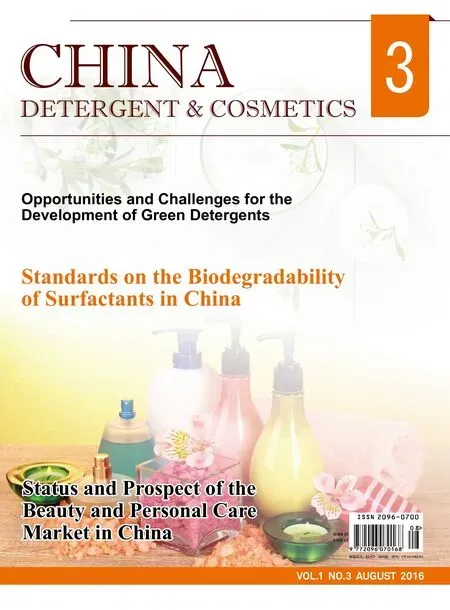 China Detergent & Cosmetics2016年3期
China Detergent & Cosmetics2016年3期
- China Detergent & Cosmetics的其它文章
- Latest Research Progress of Alkyl Polyglycosides
- Impact of Air Pollution on Skin
- Recent Development on Zero-Phosphate Spray Dried Detergent Powders Incorporated with Palm C16 Methyl Ester Sulfonates
- An Introduction to the Standardization of China Oral Care Products (Toothpaste) Industry
- Comparative Study on the Domestic and Abroad Patent Application about Liquid Laundry
- Qualitative Identification of Propylene Tetramer Alkylbenzene Sulfonate and Alkylphenol Polyoxyethylene in Laundry Powders
